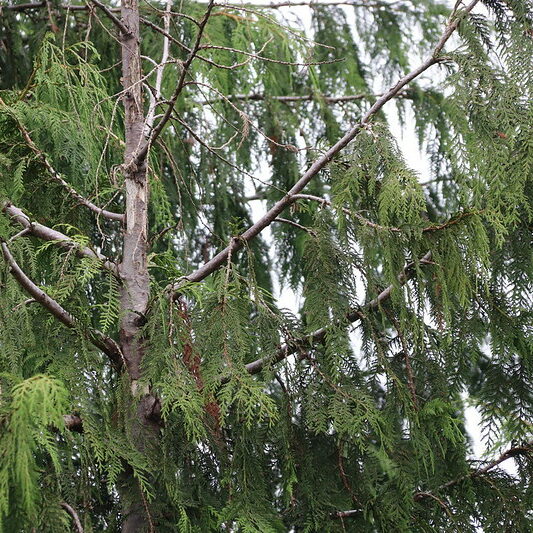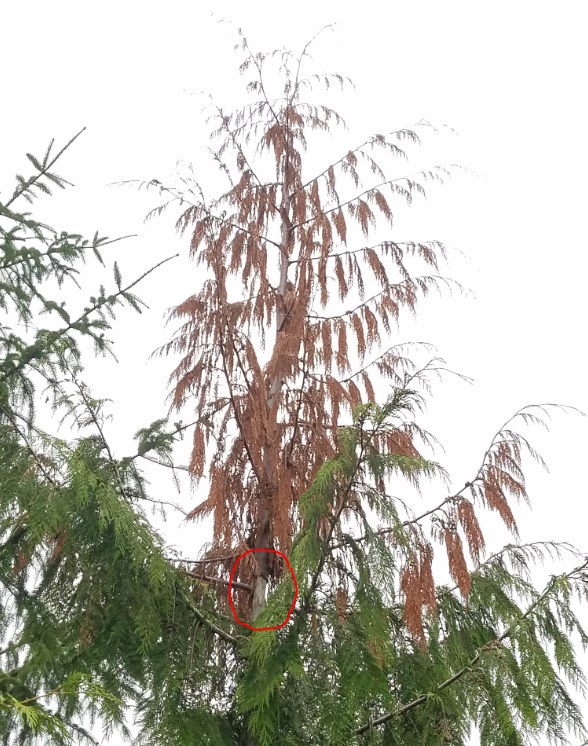Western Redcedar Topkill
Host(s) in Alaska:
western redcedar (Thuja plicata)
Affected tree part(s): tree tops or whole trees
Content prepared by Robin Mulvey, Forest Health Protection, robin.mulvey@usda.gov.

Links to Resources & Publications
Drought Stress in Conifers, Forest Health Fact Sheet from the Oregon Department of Forestry
Forest Health Highlights in Washington- 2015
Antos, J.A., Filipescu, C.N., Negrave, R.W. 2016. Ecology of western redcedar (Thuja plicata): Implications for management of a high-value multiple-use resource. Forest Ecology and Management 375: 211-222. Abstract available here.
Minore, D. 1983. Western redcedar—a literature review. Gen. Tech. Rep. PNW-GTR-150. Portland, OR: U.S. Department of Agriculture, Forest Service, Pacific Northwest Forest and Range Experiment Station. 75 p. Available here.
Tesky, J. L. 1992. Thuja plicata. In: Fire Effects Information System, [Online]. U.S. Department of Agriculture, Forest Service, Rocky Mountain Research Station, Fire Sciences Laboratory (Producer). Available here.
Dead tops and multi-forked dead tops of western redcedar are common in old-growth forests. It is possible that the active damage observed recently is caused by the same factors as this common, older damage. Synchronized active mortality of western redcedar tree tops and whole trees is not frequently observed in Southeast Alaska as it was on Prince of Wales Island in 2017. Scattered, damaged trees were generally open-grown and vigorous before damage occurred. Affected trees ranged from 5 to 40 feet tall and up to 12 inches in diameter. Most had 5 to 60% of the tree crown killed, while a few trees were killed outright. Sections of missing bark/bole wounds were common in the mid and upper tree bole immediately below and interspersed throughout dead parts of the crown. Individual wounds did not usually completely encircle stems, but were aggregated together on and around the bole such that girdling could occur. Dead tops were full and bright red, indicating rapid onset within weeks rather than progressive damage over months or years.

Further assessment of damaged trees could reveal common site factors associated with the damage, and could also help to evaluate the role of animals in wounding tree boles. It is possible that animal feeding on western redcedar was triggered by a reduction in the availability of normal food sources, and it is curious that other conifer species were apparently unaffected. The indeterminate growth of western redcedar might make it more valuable as an early food source; more flexible release from winter dormancy could provide animals with earlier access to photosynthetic products in the phloem tissue compared to associated conifers. Special thanks to Molly Simonson, Tongass National Forest Silviculturist in Thorne Bay, for sharing thorough observations of this damage.
On wet sites, western redcedar can be shallow-rooted, making them more vulnerable to drought injury during abnormally dry periods. In March 2017, late-winter drought resulted in pronounced green needle drop from Sitka spruce and western hemlock at many locations in Southeast Alaska; trees recovered quickly with normal budbreak. Rainfall throughout the 2018 growing season was far below average.
